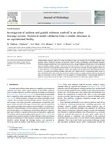Mostrar o rexistro simple do ítem
Investigation of uniform and graded sediment wash-off in an urban drainage system: numerical model validation from a rainfall simulator in an experimental facility
| dc.contributor.author | Addison-Atkinson, William | |
| dc.contributor.author | Chen, Albert S. | |
| dc.contributor.author | Memon, Fayyaz Ali | |
| dc.contributor.author | Anta, Jose | |
| dc.contributor.author | Naves, Juan | |
| dc.contributor.author | Cea, Luis | |
| dc.date.accessioned | 2023-12-27T13:06:51Z | |
| dc.date.available | 2023-12-27T13:06:51Z | |
| dc.date.issued | 2024 | |
| dc.identifier.citation | Addison-Atkinson, W.; Chen, A.S.; Memon, F.A., Anta, Jose, Naves, J.; Cea, L. (2024) Investigation of uniform and graded sediment wash-off in an urban drainage system: Numerical model validation from a rainfall simulator in an experimental facility. Journal of Hydrology, v.629, 130561. https://doi.org/10.1016/j.jhydrol.2023.130561 | es_ES |
| dc.identifier.uri | http://hdl.handle.net/2183/34670 | |
| dc.description.abstract | [Abstract:] Understanding sediment wash-off in urban environments plays an essential role in sediment transport management; and is critical for accurate pluvial flood control to assist in adaptation and mitigation strategies. Sediment transport models have been researched previously, though challenges still arise due to the complicated nature of graded sediment transport. This study tested the accuracy of the van Rijn model using a sparse distribution of particle sizes using the geometric mean. As such, this study used high-resolution datasets collected in a water laboratory to investigate sediment wash-off and transport on an urban street. This included the interaction of two gully pots receiving sediment loads that were washed off from a hypothetical urban surface by three rainfall intensities. The results showed that the model was able to simulate uniform sediments entering the gully pots accurately when the sediment size was assigned to a median diameter. Using the grain diameter to represent the geometric mean can improve the model performance for simulating a graded sediment. | es_ES |
| dc.description.sponsorship | EPSRC Centre for Doctoral Training in Water Informatics Science and Engineering, WISE CDT; EP/L016214/1 | es_ES |
| dc.description.sponsorship | The work presented in this paper was carried out as part of PhD research and was supported by the EPSRC Centre for Doctoral Training in Water Informatics Science and Engineering (WISE CDT; EP/L016214/1). The experimental part and data collection received funding from the Spanish Ministry of Science, Innovation and Universities under POREDRAIN project RTI2018-094217-B-C33 (MINECO/FEDER-EU). The authors would also like to thank the Danish Hydraulic Institute for supplying the academic license for the MIKE 21 model. | es_ES |
| dc.language.iso | eng | es_ES |
| dc.publisher | Elsevier | es_ES |
| dc.relation.uri | https://doi.org/10.1016/j.jhydrol.2023.130561 | es_ES |
| dc.rights | Atribución 3.0 España | es_ES |
| dc.rights.uri | http://creativecommons.org/licenses/by/3.0/es/ | * |
| dc.subject | Sediment transport | es_ES |
| dc.subject | Sediment wash-off | es_ES |
| dc.subject | Rainfall intensities | es_ES |
| dc.subject | Van Rijn model | es_ES |
| dc.title | Investigation of uniform and graded sediment wash-off in an urban drainage system: numerical model validation from a rainfall simulator in an experimental facility | es_ES |
| dc.type | journal article | es_ES |
| dc.rights.accessRights | open access | es_ES |
| UDC.journalTitle | Journal of Hydrology | es_ES |
| UDC.volume | 629 | es_ES |
| UDC.startPage | 130561 | es_ES |
| dc.identifier.doi | 10.1016/j.jhydrol.2023.130561 | |
| UDC.coleccion | Investigación | es_ES |
| UDC.departamento | Enxeñaría Civil | es_ES |
| UDC.grupoInv | Enxeñaría da Auga e do Medio Ambiente (GEAMA) | es_ES |
| UDC.institutoCentro | CITEEC - Centro de Innovación Tecnolóxica en Edificación e Enxeñaría Civil | es_ES |
| dc.relation.projectID | info:eu-repo/grantAgreement/AEI/Plan Estatal de Investigación Científica y Técnica y de Innovación 2017-2020/RTI2018-094217-B-C33 | es_ES |
Ficheiros no ítem
Este ítem aparece na(s) seguinte(s) colección(s)
-
Investigación (ETSECCP) [826]






